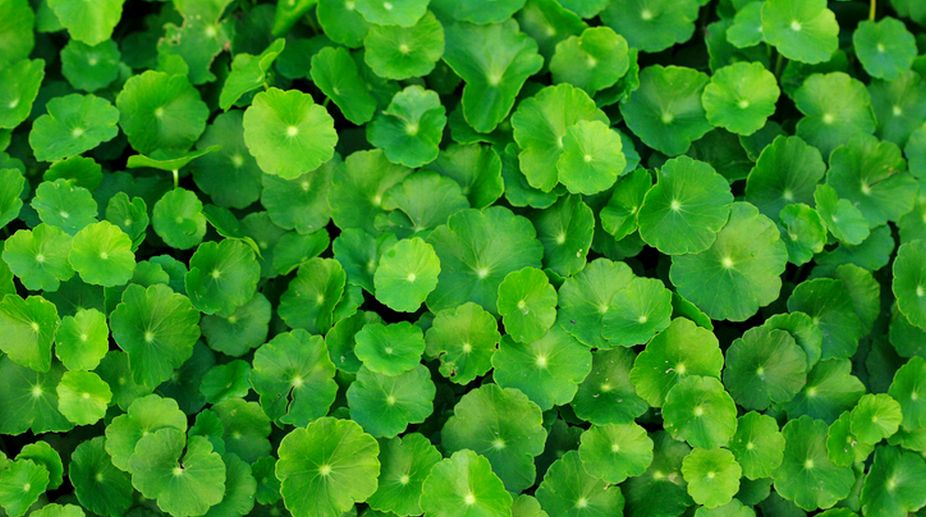What I like specially about Indian herbals is that they provide for many human failings that allopathy, preoccupied with diseases and injuries, fails to take note of. Take, for example, the Indian penny-wort, Centella asiatica, common along irrigation channels and around rice fields. It has long been recognised in our lore that its reniform leaves increase lactation in milch cattle, but that is not their main virtue.
Here is what a handbook on our weeds has to say on the versatile benignity of the herb, “The whole plant is highly medicinal… It is a tonic and blood purifier, and improves the memory. Fresh leaves eaten every day are believed to have the property of prolonging life”. Well, that is the kind of promise that few patent medicines and proprietary drugs known to allopathy hold out, even in the advertisements of their makers. Don't think, for a moment that I am ridiculing the extraordinary claims of our herbalists for certain weeds and soft-tissued plants — I neither believe nor disbelieve these claims, but I do think that there might be truth, benefit, and relief, in some of them and it is a fact that Western science has still to investigate most of these claims.
Advertisement
Unlike European systems of medicine indigenous herbal lore has no use for a placebo or even a mere palliative — its aim is positive and therapeutic, it seeks to cure. And the truth is that Western scientific curiosity has not, as yet, painstakingly verified the empirical worth and even the blind beliefs of Indian herbals Maybe a few claims have been investigated and found largely imaginative, but some others have been proved substantially true (remember Rauwolfix serpentina?). Moreover, the flagrantly displayed peculiarities of some of our plants merit thorough examination, irrespective of their medicinal value.
Some time ago, I pointed out in this column that the sweetness that amla fruit and wood can impart to brackish water, and the numbing astringency of the leaves of Gymnema sylvestre that turns sugar into sand in the mouth have not been analysed so far by Western science, despite being so remarkable in themselves. I hoped for a contradiction from some biochemist but no contradiction was made.
Let me be more specific. Here are some of the prescriptions of Southern herbal lore (very likely they have currency in other parts of India as well) which it would be specially rewarding to analyse and verify scientifically. The leaf juice, or ground green leaves mixed with buttermilk, of the inconspicuous wasteland weed. Phyllanthus niruri is of very real efficacy in jaundice; it is also given fro certain types of dysentery.We know that the bitter alkaloid in the little herb is phyllanthin but since other species of the genus are not used in jaundice, it could be that the plant contains other or ancillary principles that render it so valuable medicinally.
Another plant of the same family (the Euphorbiaceae) much in demand in indigenous drug-houses is the milkyjuiced herb, Euphorbia hirta. A peculiar-looking plant is the Aristolochia bracteata with an intensely bitter taste, used to kill intestinal worms, and maggots in deep-seated wounds and sores. We call it the “weed the goat will not eat” in Tamil and I am sure that anything the goat avoids must be powerfully potent!
A succulent gregarious herb of marshy places is the Moniera cuneifolia highly valued in the South as a nervine tonic; today, with the stress and strain of life so very much in evidence, the plant might prove very useful medicinally. Celebrated, for its cooling properties, is Eclipta alba especially when boiled with hair oil; it is said to be specially good for the eye, and is another plant worth careful investigation.
In saying this I must make it clear that I belong to that school, which thinks that though allopathy is superior to other systems in dealing with diseases (particularly epidemics) and injuries, it has still little solace to offer to such peculiarly Indian ailments as wind in the joints and heat in the eye.
Allopathy just laughs at these enervating and distressing complaints and is inclined t think of them as superstitious beliefs or at best, mere symptoms. And still you know as well as I do that both wind in the joints and heat in the eye are very real maladies, particularly apt to afflict our more traditional and orthodox uncles and aunts.
I have left out many plants long celebrated in Indian medicinal lore, such as Solanum xanthocarpum and species of Indigojera, because I am mentioning only those plants which I think of possible authentic medicinal value, from personal knowledge. But in passing I may add that one of the few palliatives that the native herbalist has is the leaf juice of Trianthema decandra, which “dropped into the nostrils relieves one-sided headache”. I suffer from migraine myself on occasion, but have so far not tried this relief.
Not all plants valued by the Indian herbalist today are indigenous. I will mention only one other herb, as an exotic with undoubted antiseptic properties recognised in our country lore. The tropical American herb, Tridax procumbens, came into India some 170 years ago and is now widely naturalised all over the country.
(This was published on 21 November 1965 in the Sunday Statesman)











